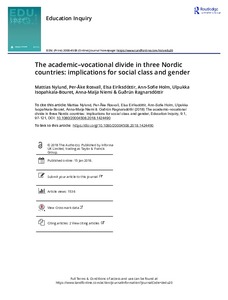The academic–vocational divide in three Nordic countries: implications for social class and gender
Mattias Nylund; Per-Åke Rosvall; Elsa Eiríksdóttir; Ann-Sofie Holm; Ulpukka Isopahkala-Bouret; Anna-Maija Niemi & Guðrún Ragnarsdóttir
https://urn.fi/URN:NBN:fi-fe2021042821075
Tiivistelmä
In this study we examine how the academic–vocational divide is
manifested today in Finland, Iceland and Sweden in the division between
vocationally (VET) and academicallyoriented programmes at the
upper-secondary school level. The paper is based on a critical
re-analysis of results from previous studies; in it we investigate the
implications of this divide for class and gender inequalities. The
theoretical lens used for the synthesis is based on Bernstein´s theory
of pedagogic codes. In the re-analysis we draw on previous studies of
policy, curriculum and educational praxis as well as official
statistics. The main conclusions are that contemporary policy and
curriculum trends in all three countries are dominated by a neo-liberal
discourse stressing principles such as “market relevance” and
employability. This trend strengthens the academic–vocational divide,
mainly through an organisation of knowledge in VET that separates it
from more general and theoretical elements. This trend also seems to
affect VET students’ transitions in terms of reduced access to higher
education, particularly in male-dominated programmes. We also identify
low expectations for VET students, manifested through choice of
textbooks and tasks, organisation of teacher teams and the advice of
career counsellors.
Kokoelmat
- Rinnakkaistallenteet [27094]
